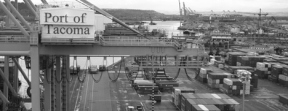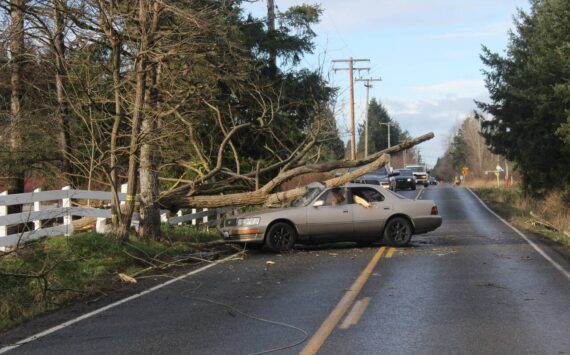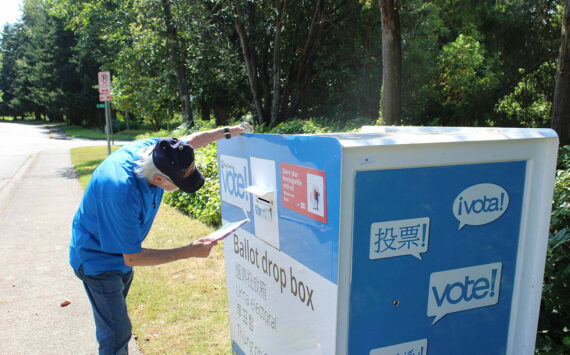The ports of Seattle, Tacoma and Vancouver, Canada have proposed performance goals to reduce particulate matter by 70 percent from ships at berth and 30 percent from cargo handling equipment, according to the Pacific Northwest Ports Clean Air Strategy announced Wednesday.
The strategy proposes performance goals aimed at reducing diesel emissions and greenhouse gases from port-related sources.
The three ports plan to accomplish the emissions reduction goals for ships and cargo handling equipment by 2010. The strategy also will address emissions from port-related truck, train and harbor craft activity and includes long-term goals for additional emissions reductions.
“The three ports have agreed to work together to cut maritime air emissions because the Puget Sound/Georgia Basin air shed is where we all live and breathe,” said Tay Yoshitani, CEO of the Port of Seattle. “Working collaboratively is the best way to do the job.”
“Because ports are in or near major cities, protecting air quality is a top public health priority,” said Elin Miller, EPA Northwest Regional Administrator. “Thanks to the commitment and hard work of our partners, Pacific Northwest ports are poised to become a ‘safe harbor’ of cleaner air, allowing all Puget Sound and Georgia Basin residents to breathe a little easier.”
A framework plan was released Wednesday, but the ports will continue to work together over the summer with their customers, tenants and other stakeholders to iron out the details. The plan will be submitted in the fall to the Port of Seattle and Port of Tacoma Commissions and to the Vancouver Port Authority Board of Directors for final approval in December.
“We want to take proactive measures to reduce emissions,” said Lou Paulsen, Senior Director, Facilities Development, Port of Tacoma. “The Puget Sound Maritime Air Emissions Inventory, which was released in April, provides us with the baseline data we need to set goals and theres no reason to wait.”
The inventory the most extensive study of its type ever completed in the United States was the work of a broad range of partners in the public and private sectors. It identified the nature and sources of maritime-related air emissions from the Canada-United States border to south Puget Sound. The data in the inventory was collected in 2005, establishing the baseline against which future reductions in emissions will be measured.
“We are in the midst of completing our own air emissions inventory in the Georgia Basin of southwest British Columbia,” said Darrell Desjardin, Director, Environmental Programs, Vancouver Port Authority. The Canadian inventory also uses 2005 data.
As the emissions reduction plan is further developed, the three ports will identify specific performance goals and emissions reduction targets for port-related trucking, rail and harbor craft (ferries, tug boats, etc.) activities. Goals already have been proposed for ocean-going vessels and cargo-handling equipment. Performance goals set clear targets but do not prescribe how to reach those targets.
“We’re pleased the ports have joined together to take action on diesel emissions,” said Dennis McLerran, Executive Director of the Puget Sound Clean Air Agency. “The performance goal approach will help us demonstrate results and measure progress. We look forward to continuing partnerships with the ports, industry and others to ensure future growth can occur while maintaining good air quality and reducing exposure to diesel exhaust.”
For cargo ships and cruise ships that make regularly scheduled calls at the three ports, the proposed performance goal calls for a reduction in particulate matter equivalent to what can be achieved by using cleaner fuels while tied up at the pier. That would result in a 70 percent reduction in fine particulate matter by 2010.
For cargo-handling equipment, the proposed performance goal is to reach a reduction in particulate matter of 30 percent by 2010. That is equivalent to what would be achieved if all of the equipment ran on ultra-low sulfur diesel or a bio-diesel blend, along with switching to newer engines or engines retrofitted with advanced pollution control devices.
Performance goals still are to be developed for trucks, trains and harbor craft. The Ports have committed to working with the trucking industry and the railroads to develop the goals.
The Port of Vancouver and some other West Coast ports have developed strategies to deal with truck emissions. In Vancouver, a recently established program requires all container trucks to have a Truck Licensing System (TLS) license in order to gain access to port terminals.
“The TLS license sets out minimum safety and environmental requirements for trucks that operate on port property,” Vancouver’s Desjardin said.
Railroads and harbor craft operators typically do not conduct most of their business on port-owned properties. The plan calls for the ports to work with the railroads to implement existing emissions reduction measures and to explore new technologies as they become available. In regard to harbor craft, local and regional air agencies, such as the Puget Sound Clean Air Agency will take the lead.
As the plan is finalized, the ports will ask stakeholder groups to help implement emissions reduction measures and formally sign on as partners.
– – – – – – – – – – – – – – – – – – –
To read a draft version of the Northwest Ports Clean Air Strategy, visit http://www.portoftacoma.com/files/3Ports_Clean_Air_Strategy-05-16-07.pdf .





